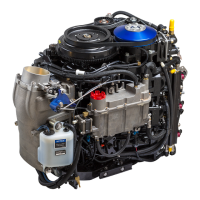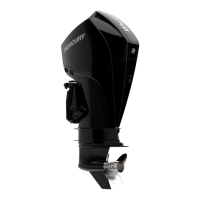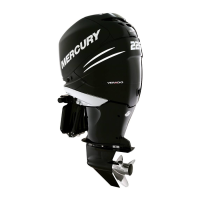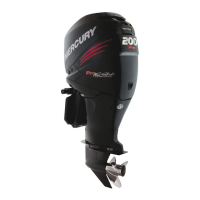DTS Power Trim Wiring Diagram
a - PCM connector A
b - PCM connector B
c - PCM connector C
d - Power trim motor
e - +12 volts power
f - Down relay
g - –12 volts ground
h - Up relay
i - Power trim harness connector
j - Power trim harness connector—PCM side
k - Trim position sensor connector
l - Cowl tilt switch
m - Main power relay
IMPORTANT: Numerical callouts shown in the circuit diagrams are test points. Refer to Troubleshooting the Down Circuit or
Troubleshooting the Up Circuit.
Troubleshooting the Down Circuit
IMPORTANT: Refer to the preceding wiring diagrams for connection points when troubleshooting the electrical systems.
Connection points are specified by number. Refer to the correct diagram for your engine (mechanical or DTS).
DMT 2004 Digital Multimeter
91‑892647A01
IMPORTANT: Perform the following tests with the engine off and the 14‑pin connector disconnected from the outboard. This
will isolate the outboard from the boat. If the engine tilts when using the cowl trim switch, the problem is related to the trim
switch at the helm.
NOTE: To access test points 2 and 8, partially remove the relay from the connector just far enough to reach the electrical
contacts with the voltmeter lead.
Step
Test Procedure Test Result
Step 1: Check for
battery voltage at
Point 1 by back
probing.
1. Connect the voltmeter black lead to
ground and the red lead to Point 1.
2. Depress the down trim button.
Battery voltage measured:
• Go to Step 2.
No battery voltage measured:
• Go to Step 3.
Step 2: Check for
battery voltage at
Point 2.
1. Connect the voltmeter black lead to
ground and the red lead to Point 2.
2. Depress the down trim button.
Battery voltage measured:
• Go to Step 5.
No battery voltage measured:
• There is an open circuit between Point 2 and the
PCM.
• Check for loose or corroded connections.
• Inspect the wiring harness for opens, shorts, or
damage. Repair or replace the harness.
Step 3: Check for
continuity between
Point 1 and Point 5.
1. Disconnect the 3‑pin connector.
2. Connect the voltmeter black lead to
Point 1 and the red lead to Point 5.
Continuity measured (resistance should be 5.6 kΩ ±
20%):
• Harness and PCM are OK.
• Go to Step 4.
No continuity measured (resistance should be 5.6 kΩ ±
20%):
• Inspect the wiring harness for opens, shorts, or
damage. Repair or replace the harness.
Step 4: Check for
battery voltage at
Point 6.
1. Connect the voltmeter red lead to
Point 6 and black lead to ground.
Battery voltage measured:
• Trim switch is faulty.
No battery voltage measured:
• Check for loose or corroded wire at Point 6.
• Open circuit in wire supplying current between Point
6 and Point 7.
Step 5: Check for
battery voltage at
Point 3.
1. Connect the voltmeter red lead to
Point 3 (female bullet connector) and
black lead to ground.
2. Depress the down trim button.
Battery voltage measured:
• Go to Step 6.
No battery voltage measured:
• Relay is defective.
Conventional Midsection (CMS) Power Trim
90-8M0146617 eng JULY 2018 © 2018 Mercury Marine Page 6C-7
